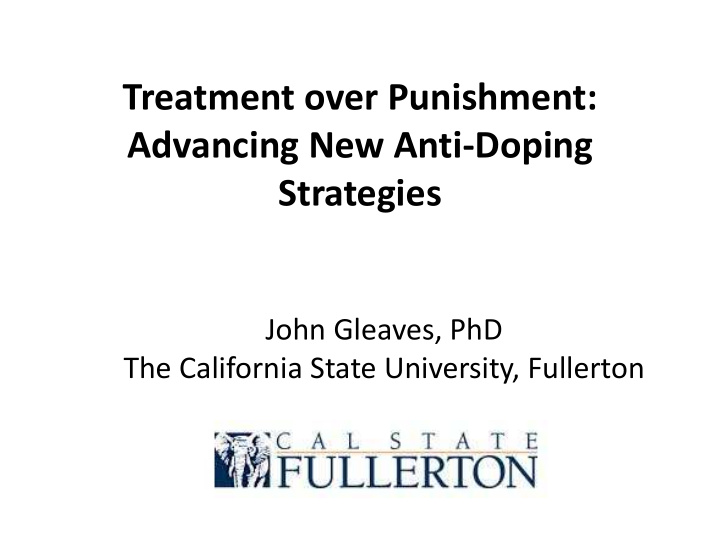



Treatment over Punishment: Advancing New Anti-Doping Strategies John Gleaves, PhD The California State University, Fullerton
What is WADA’s Goal • “WADA works towards a vision of a world where all athletes compete in a doping-free sporting environment.”
WADA Has Three Anti-Doping Prongs Focused on Athletes Education Testing Punishment
WADA’s three prongs have made progress, but still room for improvement 90% 80% 70% 60% 50% Users Even if we acknowledge 40% Positive Tests progress, we still see 30% Punishments room for improvement. 20% 10% 0% 1999 2000 2001 2003 2002 2005 2008 2009 2010 2011 Representation; Not actual data
Perhaps consider adding a fourth option: Treatment Education Treatment Testing Punishment
Two reasons to consider treatment as a viable option 1. Pathology may influence choice to dope 2. Doping in sport may result in dependence
Conformity to sporting norms From Jay Coakley, Sport in Society
“ Overconformity ” responsible for athletes some doping in sport Result of extreme devotion to pursuit of athletic excellence
If overconformity is responsible for some doping, those cases would represent pathology and not cheating Does this change how sports should address the issue?
Second; doping in sport may result in dependence 81.3% of substances WADA identified in tests are associated with physical dependence. At least some of those athletes may have a dependence (some may not)
Dependence may result in recidivism or escalating drug issues For example: Marco Pantani • Multiple doping offenses • Death due to overdose
All should receive education, many will dissuaded by sanctions, at least some will need treatment Treatment Sanctions Preventative Education
Practical benefit to WADA’s goal: Treatment may prevent future anti- doping violations Athletes who have addiction and are not treated will be likely to return to addicted behavior when they return to competition
Four suggestions 1. Decrease negative rhetoric surrounding athletes who test positive. 2. Develop treatment programs specifically designed for athletes with doping-related needs 3. Encourage athletes with incentives to complete treatment programs 4. Invest in research designed to understand psychological factors that drive athletes to dope in order to identify preventive measures.
Recommend
More recommend